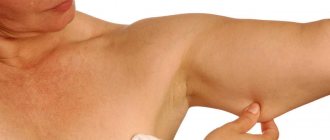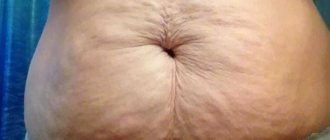Cellulite is a very common disease, which in one form or another occurs in almost 90% of all representatives of the fair sex. As a rule, orange peel does not develop only in those who are not genetically predisposed to it. Contrary to popular belief, the disease does not only affect obese women.
You can often encounter a situation where a girl is thin but has cellulite. In slender people, orange peel can appear approximately as often as in overweight people. The main difference is that excess weight leads to more rapid progression of the disease, its manifestations are more noticeable.
Myths
There are a number of serious misconceptions regarding cellulite that prevent many women from coping with this problem:
- The first myth is that “orange peel” can only appear in obese women. This misconception has long been debunked. Slender representatives of the fair sex are also susceptible to pathology, since the cause of cellulite is not always excess weight.
- The second myth is that all women suffer from cellulite. There is an opinion that after 18-20 years, all girls develop small pits and bumps on their skin. The difference lies only in the severity of the pathology. Indeed, many women are susceptible to cellulite, but this does not mean that everyone has it.
- Myth three – it is impossible to cope with cellulite, especially if there is a hereditary predisposition. Experts do not recommend leaving the situation to chance - proper nutrition and physical activity help eliminate the problem.
Is there a difference between cellulite and “regular” fat?
"Cellulite" is not a medical term. From a medical point of view, this is simply a fatty layer of the body, that is, the norm: for doctors and biologists there is simply no problem with this. To understand the characteristics of fat deposits, scientists gathered men and women with and without cellulite, and took samples of subcutaneous tissue from each of them from “problem” areas and areas not affected by the visible layer. A series of tests were then carried out to determine whether samples of material from cellulite areas differed in biochemical composition or tissue condition. In repeated tests, it was found that there is no difference between cellulite and normal fat tissue, and its presence is not associated with either health or life expectancy. Despite this, cosmetologists continue to call cellulite lipodystrophy, cleverly substituting concepts.
The characteristic appearance of fatty deposits, however, has its reasons. The subcutaneous layer contains fat cells and adipocytes. Fibers that connect the skin to deep tissues form cells containing accumulations of fat. When fat cells increase in size, these “compartments” form bulges on the surface of the skin. Women's adipocytes are larger than men's and have the ability to store more fat. Women, as a rule, have naturally more sensitive, thin and elastic skin - fat underneath is especially noticeable. However, due to age-related degeneration of the skin or a sedentary lifestyle, cellulite can become even more visible.
In the body of the average woman without excess body weight, the percentage of fat is, in principle, higher than in the male body. This difference appears with puberty and persists throughout life, being a consequence of biochemical sex differences. The accumulation of body fat during adolescence ensures the normal course of a hypothetical pregnancy in the future. The reason for this difference is in the female sex hormones estrogens: it is thanks to them that the distribution of fat in the body occurs “according to the female type” (there is more of it on the buttocks and thighs), and its accumulation is many times more efficient. Moreover, adipose tissue is largely responsible for the production of hormones, including estrogens - which is why those who lose too much fat from fasting or exercise may miss their periods.
Reasons for appearance
The appearance of “orange peel” on the body is caused by stagnation in the structure of adipose tissue:
- When the nutrition of the subcutaneous tissue is disrupted, harmful substances accumulate in it.
- Fluid appears between the cells, collagen fibers harden, and nodules form from fat cells.
- All this provokes the appearance of bumps and swelling on the skin.
Both overweight and thin people can encounter such metabolic disorders. The presence of excess weight is not a provoking factor in this case.
The most common causes of the problem in thin women include the following:
- Hereditary predisposition. The presence of pathology in close relatives creates the preconditions for its occurrence. This is due to the presence of an excess number of fat-storing cells, vascular weakness, and high sensitivity to the action of female hormones.
- Smoking. When nicotine enters the body, small vessels contract, including those that penetrate adipose tissue. As a result, the intensity of blood circulation is disrupted, which leads to stagnant processes in the tissues and the appearance of cellulite.
- Insufficiently active lifestyle. During the day, excess fluid accumulates in the tissues of the lower extremities. This leads to stretching of the skin. With a deficiency of motor activity, this fluid is stored in the structure of the epithelium, and then transformed into fibrous tissue that damages the capillaries.
In addition, a sedentary lifestyle causes pressure on the hips and buttocks. This also damages capillaries and lymphatic vessels. As a result, the blood supply to tissues with useful substances and oxygen is disrupted. Lymph and blood penetrate the tissues, which leads to the appearance of the disease.
- Wearing tight clothes. Tight jeans and tight underwear cause compression of the inguinal canal. This leads to disruption of the outflow of venous blood and lymph. As a result, cellulite appears.
- Stressful situations. With nervous excitement, the functioning of the adrenal glands is activated, and a large amount of adrenaline enters the blood. This hormone stimulates increased fat accumulation. In this case, deposits predominantly occur on the thighs and buttocks.
- Hormonal fluctuations. This problem appears under the influence of estrogen, progesterone and growth hormone. These substances affect the distribution of fat deposits. Female hormones are especially activated during adolescence, during pregnancy, and when taking hormonal drugs.
As a result, intense accumulation of fat occurs, and venous outflow slows down. As a result of these processes, cellulite appears.
- Poor nutrition. Eating foods that contain a lot of aromatic additives, dyes and preservatives leads to disruption of the digestive system. As a result, damage to adipose tissue, accumulation of water, and weight gain are observed.
- Age-related changes. As the body ages, there is a strong compaction of collagen fibers that penetrate the adipose tissue. As a result, the skin loses its elasticity, which leads to the formation of cellulite.
Who invented cellulite
Young girls are afraid of him, women shamefully delete photographs spoiled by him, and retouchers all over the world sit day and night in Photoshop, smoothing out the bumpy skin on the thighs of world-famous models. The Internet is full of advice, and the market is full of cellulite elimination services. There are an endless number of anti-cellulite products. Creams and serums, scrubs and wraps, brushes and massagers, herbs and algae, electrical stimulation devices, injections and surgeries - all this exists only to help us cope with what is groundlessly considered a sign of laziness, unhealthyness and unattractiveness.
Surprisingly, cellulite as a global problem is not even fifty years old. Thanks to painters such as Rembrandt, Rubens and Courbet, the shimmer of light on uneven female buttocks, thighs and bellies adorn the best museums in the world. Hollywood divas also did not think that cellulite needed to be treated. Even advertising photographs of the legendary actresses Marilyn Monroe and Jayne Mansfield or the erotic model Bettie Page never occurred to anyone to retouch.
In the 1920s, the French came up with a name for the appearance of women's skin on the thighs, buttocks and shoulders - "orange peel". But even then, no one said that unevenness on a woman’s body is bad, that it is not the norm, but an unpleasant exception. Within half a century, however, the idea of cellulite had crossed the Atlantic: in 1973, enterprising New York beauty salon owner Nicole Ronsard published Cellulite: Those Lumps, Lumps and Lumps You Couldn't Get Rid of Before. The work was immediately reviewed by Vogue magazine, purchased by two hundred thousand women, and then republished several times as a bestseller.
The book stated that cellulite is the “wrong” fat, and a lumpy butt is a sign of impaired blood and lymph flow and the cause of the accumulation of toxic substances that the body cannot cope with. In those pre-Photoshop days, Ronsard had to work hard to find a model without cellulite to advertise the book: only the thirtieth girl who came to the casting did not have it. But in the end, the author hit the jackpot by starting to sell “anti-cellulite” cosmetic services: from ointments to massages. Sales of cactus washcloths, hard loofahs, magic creams, and vitamin supplements immediately soared.
After some time, in order to reach an even larger circle of consumers, four stages of cellulite development were invented. The last of them was described as similar to fibrosis, and the first was called ingeniously - “hidden cellulite” - and seemed to hint that if you don’t have cellulite, you should still be afraid, because it’s just hiding. To detect it, it is recommended to squeeze suspicious areas, find fat cells under the skin - and urgently rush to the procedure. In subsequent years, the cosmetic market took up the idea of cellulite, not unreasonably seeing a gold mine in the female fat layer. Courses of “treatment” cost hundreds of dollars for clients.
The American Medical Association declared back in 1978 that there is no such diagnosis as cellulite, and, of course, it was never included in the International Classification of Diseases. However, frightened consumers began to believe that the cream could penetrate the skin and dissolve fat cells, that polyethylene wraps would help “evaporate” them, and that there were anti-cellulite exercises for “problem areas.” There was even an idea that cellulite is not fat, but a gel-like substance made of water, fat and toxins, which can be eliminated by diet. Not long ago, a horror story was born that cellulite is a sign of endocrine diseases, problems with the thyroid or pancreas.
Where does it appear?
Cellulite in thin girls can appear in the same areas as in overweight girls.
First of all they suffer:
- hips,
- buttocks,
- stomach,
- legs,
- hands.
Find out why cellulite appears during pregnancy.
How to do exercises for cellulite? Instructions here.
Manual massage
The next type of massage is manual. It needs to be done by a specialist. Using a special massage technique, stagnant fat deposits in the buttocks, legs and thighs are broken down. Blood circulation in problem areas improves. After just ten sessions, lymph exchange in the area of the greatest accumulation of cellulite returns to normal.
But not everyone has the money and time to regularly visit a massage therapist. You can do it yourself. The main thing you need to remember is that you cannot hit or stretch your buttocks and thighs painfully. The inner thigh, groin area and lower abdomen need to be massaged very carefully and gently! Otherwise, it can lead to serious negative consequences!
Now let’s bring to your attention the self-massage technique itself, which will help thin people. She will also help complete people. But there is no need to create illusions; if you are overweight, you cannot do without losing weight. Before self-massage, you must warm up problem areas. If possible, carry out this procedure in a bath or sauna. If not, use your bathroom. After a steam room or just after a hot shower, rub your legs, thighs and buttocks with a wet towel. Then gently massage the desired areas with smooth movements. Be sure to lubricate your hands with oil or cream. Olive oil works well for this purpose.
How to get rid of cellulite in thin girls
When skin problems occur, it is very important to eat a healthy and balanced diet. Strict diets will not be effective in this case. Experts advise adjusting your menu in accordance with the principles of proper nutrition. Adequate physical activity and other methods play an important role in getting rid of cellulite.
The most effective methods of therapy include the following:
- aerobic exercise – running, swimming, active gymnastics, dancing;
- use of special dietary supplements - conjugated linoleic acid, amino acid L-carnitine, etc. are suitable for this purpose;
- elimination of bad habits - smoking and drinking alcoholic beverages;
- massage – honey procedure and vacuum massage, which is performed using pneumatic cans, are especially effective;
- anti-cellulite wraps;
- cold and hot shower;
- the use of cosmetics with tightening and stimulating properties - you can use various gels, serums and creams;
- plentiful nutrition - you need to drink at least 1.5-2 liters of clean water per day;
- performing strength exercises for problem areas of the body - abdomen, buttocks, thighs;
- increasing physical activity during the day;
- adherence to the principles of healthy eating.
In advanced cases, it is quite difficult to cope with the problem on your own. In such a situation, effective salon procedures will come to the rescue.
These include the following:
- vacuum cavitation;
- mesotherapy;
- lymphatic drainage or anti-cellulite massage;
- ultrasonic liposuction;
- intralipotherapy;
- ozone therapy;
- salon wraps.
Salon methods to combat cellulite
When the problem reaches its final stage, it will not be possible to remove it at home. In this case, beauty salon specialists can help.
The main ways to get rid of “orange peel” include:
- ultrasonic liposuction;
- ozone therapy;
- vacuum cavitation;
- wraps with special means;
- anti-cellulite and lymphatic drainage massage;
- intralipotherapy.
The fight against “orange peel” is a long process, so it will not be possible to achieve quick results.
Home Recipes
Effective home treatments will help eliminate cellulite in thin girls.
One of the most effective methods is cupping massage using oils.
To do this, you should choose a base oil - peach, almond or olive are perfect. It can be supplemented with essential oils of lemon, orange, juniper.
You can also use the following recipes at home:
- Coffee scrub. Mix coffee grounds, sea salt, ground oatmeal, cocoa powder, cinnamon. Add 5 drops of lemon or orange essential oil to a tablespoon of the mixture. Dilute the resulting composition slightly with water and apply to problem areas of the skin. Massage a little and rinse.
- Cream mask. Take a couple of teaspoons of any cream, add 5 large spoons of grape juice and 1 small spoon of honey. Apply the resulting composition to problem areas, hold for 20 minutes and rinse.
- Parsley infusion. Take a couple of tablespoons of chopped parsley, add 1.5 liters of boiling water and leave to brew. Take 2 tablespoons of the strained product on an empty stomach. This needs to be done 4 times a day. Duration of treatment – 2 weeks. With the help of infusion, you can improve lipid metabolism and cope with waste and toxins.
- Vinegar wrap. Mix apple cider vinegar and water in equal parts, add a few drops of lemon essential oil. Moisten gauze in the resulting solution and wrap it around the problem areas. Place the film on top and wrap yourself in a blanket. After 40-60 minutes, you can take a shower and lubricate your skin with cream.
- Wraps with kelp. Take a couple of tablespoons of kelp, add hot water and leave to steep for 15 minutes. Mix the seaweed with the yolk, pour in 20 drops of camphor alcohol and 10 drops of lemon juice. Treat problem areas with the composition and wrap them with film. Keep for 45 minutes.
Possible complications
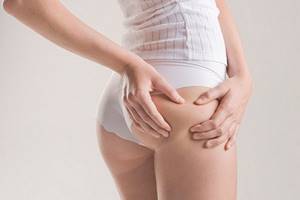
If the problem is not detected and steps are not taken to eliminate it, complications are likely to develop:
- In the absence of complications, cellulite develops quite quickly and enters a more advanced stage. It is better to start treatment in the early stages: the more advanced the cellulite, the more difficult it is to fight it;
- Slags and toxins begin to be eliminated from the body more slowly, all organs are affected by decay products, and the general condition of the patient worsens significantly;
- The risk of developing varicose veins and bedsores increases;
- In some cases, patients experience necrosis of skin tissue in areas affected by cellulite.
The role of water and diet
To cope with cellulite, it is very important to make adjustments to your diet. Even thin girls shouldn't eat everything. Instead of fatty foods, you need to eat lighter foods. It is very important to exclude fried and spicy foods. Baked goods, sweets, and carbonated drinks are prohibited.
The diet should consist of fresh fruits and vegetables. Eating seafood is also beneficial. Experts advise completely avoiding snacking and drinking alcohol.
Instead of coffee, you should drink green or herbal tea. It is recommended to replace sugar with honey. It is also very important to adhere to the drinking regime. During the day you need to drink at least 1.5-2 liters of clean water.
Read whether it is safe to use aminophylline against cellulite.
Is a sauna effective against cellulite? Follow the link.
Does flaxseed oil and coffee help with cellulite? Find out more.
What is cellulite and what does it look like?
Cellulite is also called “orange peel” because when the skin is lumpy, it looks very much like that part of a fruit. The cause of the manifestation is a violation of microcirculation and lymph flow of the subcutaneous fat layer, the growth of connective tissue begins, nodules, tubercles, pits and bluish spots appear. The thinner the skin, the more noticeable these manifestations are.
It is easier to explain what cellulite is in simple words using an example. The crusty skin resembles a crumpled napkin and begins to bulge when there is a lot of fat reserves. Fat cells grow, collagen septa thicken, protrude outward, and tubercles form from them. There are 2 types of illness:
- Hard.
Occurs in athletes who take on heavy loads; such a crust is difficult to remove because it is directly connected to the muscles. But it is also more difficult to detect. - Soft.
Affects large areas and is immediately noticeable as the skin sag. It can be treated much faster.
At what age does cellulite appear?
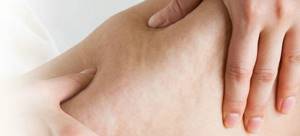
The question of how old cellulite appears is difficult to answer unambiguously. It is typical for women aged 35 and above, but can also appear in adolescence; puberty accounts for about 12% of all cases. Another 20% - during pregnancy, about 25% of cases - during menopause. It can be seen during hormonal surges in adulthood, when the skin becomes thinner and weaker.
If cellulite suddenly appears, the cause may also be poor nutrition, a sedentary lifestyle, or smoking. Heredity cannot be ruled out, this is especially true for young girls.
An examination will not be amiss, since a crust on the skin may be a symptom of kidney, liver or vascular disease.
Stages of cellulite development
With the clarification of the problem of what causes cellulite, some doctors began to note that this phenomenon cannot be called a disease. We are only talking about disorders in the body when areas of the body do not receive the necessary vitamins and suffer from toxins. Other doctors agree that we can talk about an illness that needs to be treated so as not to provoke more complex diseases.
The initial stages of cellulite are easier to treat:
- First.
A slight increase in subcutaneous fat becomes noticeable if you squeeze the skin with your fingers. With an active lifestyle and massages, the body will cope on its own. - Second.
Lumps and pits are already beginning to appear; proper nutrition, going to the gym, and body wraps help.
Prevention
To prevent the appearance of cellulite, it is very important to follow a number of recommendations:
- adhere to the principles of healthy eating;
- do exercises every day;
- give up smoking and alcohol;
- walk more in the fresh air;
- do cosmetic procedures for the skin.
Cellulite is considered a very common problem that affects many women. Slender representatives of the fair sex are no exception. To cope with this phenomenon, it is very important to make adjustments to your lifestyle - review your diet and increase your level of physical activity.
Stages of cellulite development
- Appears in adolescence. At this time, we do not think about the consequences of our lifestyle.
- In this case, serious swelling appears. The venous system cannot remove large amounts of fluid. Because of this, the pressure inside the tissues increases, swelling is formed, which contributes to the appearance of compactions.
- The outflow of fluid worsens, the process of oxygen saturation of tissues is disrupted. The swelling increases and begins to compress the arteries. Thus, oxygen does not reach the tissues. This, in turn, leads to the formation of a “mesh” of connective tissue, from which the “orange peel” is formed.
- The most painful. At this stage, additional fibers appear around the connective tissue “mesh”, which affect the nerve endings, which causes pain. Only surgery can help here.
Pay more attention to your health to maintain beauty and youth for a long time.
Cellulite is a term from the beauty industry. It is popular among cosmetologists. Doctors (for the most part) do not recognize it, nor do they consider the phenomenon itself to be a disease. Nevertheless, in the fight against cellulite, a medical approach is needed: not to suppress the symptoms, but to look for and eliminate the root cause. Therefore, first it would be good to know what cellulite is and how it appears.
Photo: Before and after
How dangerous is cellulite, how to identify it, symptoms
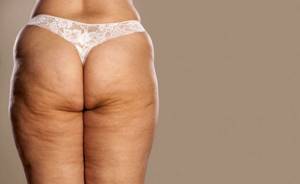
To be completely honest, the disease as such does not pose any particular danger. They say that it has a negative effect on blood vessels and provokes an increase in blood pressure, this is a myth. The culprit is most often excess body weight. It is from extra pounds that various problems arise, and cellulite is just one of its unpleasant, unsightly companions. True, in an advanced form, the nodules can be painful when squeezed, which is very unpleasant.
Complications
Despite the general safety of the disease, it still sometimes leads to complications. Now they already represent a serious problem, which can be difficult to combat.
- The formation of ulcers where there were previously hemorrhages.
- Intractable layers of purulent infections that have arisen in the area of open wounds and closed ulcerations.
- The development of so-called elephantiasis, in which lymph flow in peripheral areas is seriously impaired.
Stages of cellulite
The pathological stages of cellulite develop gradually. Therefore, diagnosing them at the initial stage can be difficult. Each stage has its own signs by which one can draw a conclusion about the presence and complexity of the problem. This will determine what steps to take and how exactly to approach solving the problem.
1: Pre-cellulite
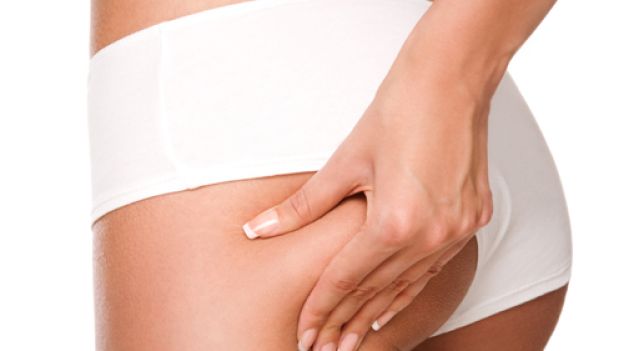
At the very beginning, you will not be able to notice any symptoms or external signs on the surface of the skin with the naked eye. However, by some signs it is possible to recognize it.
- Its most striking symptom can be considered mild swelling of the tissues.
- Bruises begin to appear on the surface of the skin even from light blows.
- Scratches and wounds take a little longer to heal than before.
At the same time, at the cellular level, after conducting a study, the doctor will definitely notice changes and deformations. The lipid layer itself increases in size, hemorrhages may occur in it, and capillary permeability is significantly worsened. This is quite easy to deal with, and the process can be stopped with one course of hardware, for example, vacuum massage.
2: Initial
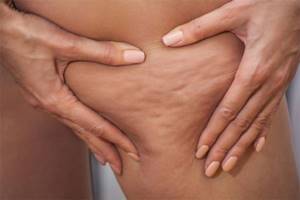
At the second stage, the woman herself can detect obvious signs of this phenomenon. When the muscles are tense or you simply grab a fold of skin with your fingers, you may notice an uneven, slightly bumpy surface. It is at this stage that pathological changes appear, which can and should still be combated.
- Pale, light marbled skin tone.
- The skin temperature in problem areas is lower, for example, the skin may feel cool to the touch.
- The elasticity of the skin begins to be lost; when pressed, they do not straighten out immediately, but slowly.
At the second stage, microcirculation of lymph and blood is already impaired.
3: Micronodular
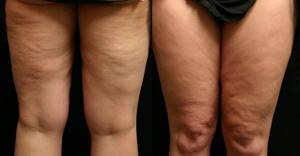
By the third stage, lipid cells begin to coalesce into clusters as the membranes between them are destroyed. At this stage, the orange peel can no longer be hidden. It is visible in both vertical and horizontal positions of the body. In this case, you don’t even need to squeeze the fold of skin with your fingers; its unevenness is clearly visible. To the touch you can clearly feel nodules and compactions.
- The temperature of the skin is much lower in problem areas, they begin to feel noticeably cold.
- Skin color may change from pale to slightly sallow or yellowish.
- Pressing on cellulite lesions is slightly painful.
- There is regular swelling
In such a situation, it is no longer possible to get rid of the problem with physical activity or massage alone. The time has come for “heavy artillery,” that is, force massage and ultrasonic influence.
4: Macronodular
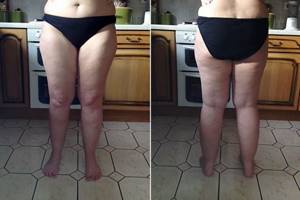
The fourth stage is considered the most severe form of the disease. In problem areas, scars are already clearly formed, swelling, and nodules are easily palpated. The temperature of these places noticeably decreases, because the circulation of blood and lymph there is slowed down to the extreme. Sometimes even necrotic phenomena are observed, that is, tissue death, but this happens in extremely rare cases.
At the fourth stage, patients require serious treatment, for example, RF lifting. Sometimes even plastic surgery is indicated.
The stages of cellulite in all problem areas of the same person are not always the same. For example, on the stomach or sides the disease may be on the second, and on the hips, buttocks on the third or fourth.
Classification of cellulite according to skin characteristics
In addition to stages, the disease is divided into separate types or forms. They may vary depending on the condition and type of skin.
- Hard has fairly dense, compact nodules that do not change in any way with changes in body position. Such tubercles are not clearly expressed and can be almost invisible, but when compressed, the folds of the skin appear. Similar phenomena are observed by young women, teenagers, and athletes. It is often accompanied by stretch marks and stretch marks.
- The flaccid appearance is characterized by lethargy and flabby muscles. The skin, along with the fat layer, shakes when moving, which reminds many of jelly, and the position of the tubercles can change shape when the body position changes. Most often, this type develops in older women who lead a sedentary or completely sedentary lifestyle. For some, it may be a direct consequence of the solid variant.
- Edematous cellulite has characteristic swelling in the affected areas. When you press on them, the dents remain for a long time and are poorly leveled. At the same time, the skin itself becomes very thin, translucent, and the vascular network is clearly visible under it. This type is less common than others, and appears most often in the lower part of the body - on the legs and hips.
- Mixed type implies the presence of different types of cellulite in one patient.
Methods for diagnosing cellulite
To diagnose the presence of a disease, as well as its stage and type, subjective and objective methods are used. In any case, there is no way to do it without a specialist.
- Anthropometric method , that is, measuring weight, height, volume, and other indicators will allow you to determine the approximate thickness of the fat layer.
- Bioelectrical impedance measurement allows you to determine the conductivity of electric current. The more adipose tissue, the lower the indicators will be, therefore, the higher the chance of having cellulite.
- Computed tomography and magnetic resonance scanning speak more about the presence and degree of obesity, but these two phenomena go hand in hand.
- Anode thermography determines the surface temperature of the skin. This allows you to calculate potentially dangerous areas.
- Bi-scan or two-dimensional echography using ultrasound of a certain frequency will help identify nodules, their size, location, and depth.
- Xerography makes it possible to personally determine the boundaries of the dermis, lipid layer, muscle tissue, and their objective indicators.
- Doppler ultrasound determines the degree of blood microcirculation in the vessels of the skin and subcutaneous tissue, thereby identifying pathologies.
Histological examination is the most reliable, accurate way to calculate the disease. However, it is performed when the integrity of the skin is violated - a piece of tissue is simply removed from a depth of four millimeters. But from it you can make a clear conclusion whether there is a problem even at the initial stage.
Treatment
Let's look at how to get rid of cellulite for a thin girl. The therapy program includes diet, physical therapy, anti-cellulite massage and a number of home treatments.
For the treatment of cellulite in thin people, a classic table with a restriction of fats and carbohydrates is recommended - such changes will prevent the appearance of “harmful” fat deposits under the skin. The basic rules are as follows:
- Eat small, frequent meals
- Limit animal fats in your diet, replace them with vegetable ones,
- Avoid mayonnaise, salt and an abundance of sweets,
- To quench your thirst, use only water, you can drink green tea, mineral water without carbon,
- Use honey instead of sugar
- Drink more fluids (at least 2 liters per day),
- Give up bad habits
- The last meal is no later than 18:00.
Physiotherapy
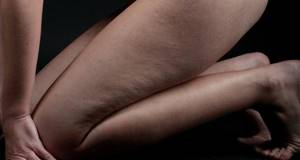
The next component of the treatment of cellulite in thin people is physical exercise. Exercise will not harm the body because it burns fat, which thin people have relatively little of (compared to fat ones). But even a slight reduction in the fiber that forms the “orange” will be a big plus in the treatment of cellulite.
The most effective types of anti-cellulite fitness are:
- Crossfit,
- Squats,
- Running or exercise bike, bicycle,
- Straight leg raise while lying on your stomach.
To create effective exercises against cellulite, it is recommended to contact a trainer.
Massage procedures ensure the development of soft tissues, improving blood flow to problem areas and relieving congestion. After warming up, the lymphatic vessels also dilate, through which drainage improves. This helps to “wash out” toxins and waste, accelerating metabolism in tissues affected by cellulite.
The following types of massage are recommended for treatment:
- Manual – to eliminate the “orange peel” you will need the services of a massage therapist. This method perfectly “breaks” cellulite, smoothes and tightens the skin,
- Hardware - at home you can use special devices. Unlike the previous method, they make it possible to perform self-massage,
- Honey - for warming up, a bee product is used, which sticks to the hands and ensures that the skin is “plucked” from cellulite fat, activating blood circulation and metabolism,
- Cupping – for massage it is better to use latex, silicone or rubber caps (they can be moved painlessly over the body). A vacuum effect is created under the jars, which sucks the skin, activating lipolysis.
Special wraps have proven themselves to be effective in helping thin women cope with cellulite. The essence of the procedures is to apply the product to the skin and then wrap it in cellophane film. A thermal effect is created under the bag, excess liquid is removed, and with it toxins and impurities. According to the mechanism of action, they are distinguished:
- Hot wraps - they use spices that provide a thermal effect. They should be used carefully so as not to cause burns.
- Cold – the composition contains algae, clay or other components that cool the skin. Such products eliminate cellulite and activate lymphatic drainage.
It is better to do wraps in the evening, apply for 5-10 minutes, then rinse with warm water.
Scrubs are actively used to cleanse the skin. The procedure involves the use of special mixtures that are applied before the shower. The composition has an exfoliating effect and contains substances to eliminate cellulite. For thin people, it is recommended to do the procedure in the evening, before going to bed, and then apply an anti-cellulite moisturizer to the skin.
Baths and creams
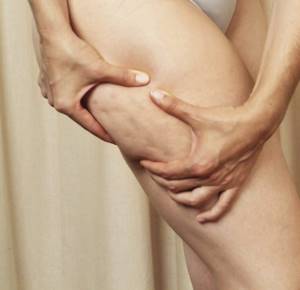
You can complete your review of the treatment of cellulite in thin women with sea salt baths. According to patient reviews, they are used to cleanse and nourish the integumentary epithelium. Salt is an excellent scrub that increases the effectiveness of the procedures. Experts do not advise washing off salt from the skin, but immediately applying anti-cellulite cream.
- Eat small, frequent meals;
- Limit animal fats in your diet, replace them with vegetable ones;
- Avoid mayonnaise, salt and an abundance of sweets;
- To quench your thirst, use only water, you can drink green tea, still mineral water;
- Use honey instead of sugar;
- Drink more fluids (at least 2 liters per day);
- Give up bad habits;
- The last meal is no later than 18:00.
Physiotherapy
- Cross-Fit;
- Squats;
- Running or exercise bike, bicycle;
- Straight leg raise while lying on your stomach.

Diet and therapeutic exercises for cellulite
Effect on skin
The most accessible and common methods of treating the skin of the legs, thighs and abdomen are contrast showers and anti-cellulite wraps. As a rule, the results from them become noticeable after 5-10 sessions. It is best to carry out the procedures in the following sequence:
- Take a warm bath;
- Apply scrub to skin;
- Carry out anti-cellulite self-massage;
- Start wrapping.
A variety of ingredients are suitable for treating leather. If a woman suffers from varicose veins, she should not use components with a warming effect. Sea salt is fine. The mixture is prepared as follows:
- A third of a glass of sea salt is crushed using a blender or coffee grinder;
- Add two tablespoons of olive oil;
- If desired, you can drop a little citrus essential oil;
- If the mixture starts to burn later, it means there was too much oil.
The finished product is spread on the areas of the body that need to be eliminated from cellulite. Everything is wrapped in a special film. If there is no sea salt, natural coffee will come to the rescue. This option is not suitable for women with varicose veins, while others can combine:
- Four tablespoons of ground coffee;
- Three tablespoons of olive oil;
- Three drops of citrus essential oil.
All ingredients must be mixed until mushy. If necessary, you can add a little water at room temperature. Problem surfaces are treated with the finished mixture, then they are covered with film. Wraps can be performed no more than three times a week, and the total course should not exceed 15 sessions. The duration of the procedure depends on the chosen recipe, but cannot exceed an hour.
Influence of third party factors
Collagen and estradiol are present in the body of all women, so why do some plump ladies not experience skin problems, while other thin ones need to get rid of cellulite? First of all, this is influenced by a person’s body type and individual characteristics of the body. However, external factors also play a role.
It is necessary to adjust your lifestyle as early as possible if you do not want to subsequently treat fibrous, advanced cellulite. This can lead to:
- Constant use of transport and elevators, little walking;
- Sedentary work;
- Lack of training both at home and in the gym;
- Sedentary lifestyle;
- Excessive consumption of junk food, including fatty, spicy, flour, processed foods and canned food;
- Addiction to smoking and alcohol;
- Stress exposure;
- Not drinking enough water;
- Hormonal contraceptives and other drugs;
- Accumulation of waste.
Finally, sometimes orange peel develops as a result of improper or no skin care. In general, the essence of the problem is that cellulite is more likely a defect of the skin, and not a consequence of excess weight. Thus, it can form even in the most slender.










